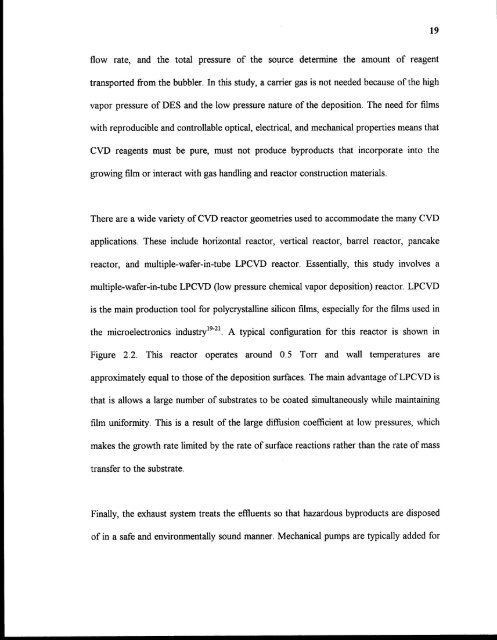njit-etd2000-029 - New Jersey Institute of Technology
njit-etd2000-029 - New Jersey Institute of Technology
njit-etd2000-029 - New Jersey Institute of Technology
You also want an ePaper? Increase the reach of your titles
YUMPU automatically turns print PDFs into web optimized ePapers that Google loves.
19<br />
flow rate, and the total pressure <strong>of</strong> the source determine the amount <strong>of</strong> reagent<br />
transported from the bubbler. In this study, a carrier gas is not needed because <strong>of</strong> the high<br />
vapor pressure <strong>of</strong> DES and the low pressure nature <strong>of</strong> the deposition. The need for films<br />
with reproducible and controllable optical, electrical, and mechanical properties means that<br />
CVD reagents must be pure, must not produce byproducts that incorporate into the<br />
growing film or interact with gas handling and reactor construction materials.<br />
There are a wide variety <strong>of</strong> CVD reactor geometries used to accommodate the many CVD<br />
applications. These include horizontal reactor, vertical reactor, barrel reactor, pancake<br />
reactor, and multiple-wafer-in-tube LPCVD reactor. Essentially, this study involves a<br />
multiple-wafer-in-tube LPCVD (low pressure chemical vapor deposition) reactor. LPCVD<br />
is the main production tool for polycrystalline silicon films, especially for the films used in<br />
the microelectronics industry 19-21. A typical configuration for this reactor is shown in<br />
Figure 2.2. This reactor operates around 0.5 Torr and wall temperatures are<br />
approximately equal to those <strong>of</strong> the deposition surfaces. The main advantage <strong>of</strong> LPCVD is<br />
that is allows a large number <strong>of</strong> substrates to be coated simultaneously while maintaining<br />
film uniformity. This is a result <strong>of</strong> the large diffusion coefficient at low pressures, which<br />
makes the growth rate limited by the rate <strong>of</strong> surface reactions rather than the rate <strong>of</strong> mass<br />
transfer to the substrate.<br />
Finally, the exhaust system treats the effluents so that hazardous byproducts are disposed<br />
<strong>of</strong> in a safe and environmentally sound manner. Mechanical pumps are typically added for
















